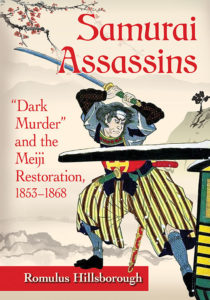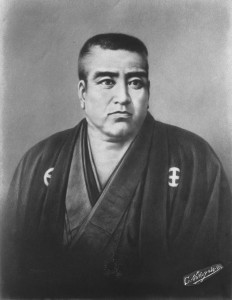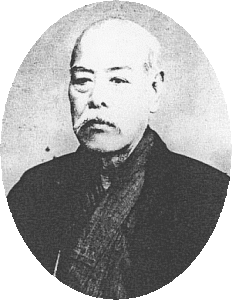
“Samurai Assassins”: The Assassination of Sakamoto Ryoma



Okada (“Man-Cutter”) Izō was one of the three most notorious assassins of the Bakumatsu era. As I wrote in my forthcoming Samurai Assassins, “… the original purpose of a sword was to kill people. But ‘in the Tokugawa era it became a philosophy. Izō [however] . . . taught himself fencing as a means of killing.’”
Okada Izō was Takechi Hanpeita’s favorite fencing student and, as it turned out, his “chief hit man” during a spree of assassinations in Kyoto and elsewhere.

(excerpted from Samurai Assassins)
Until he would conceive of the [revolutionary] Tosa Loyalist Party, Takéchi Hanpeita was first and foremost a swordsman—but the Japanese sword he wore at his side, nearly three feet long, represented “his belief in the Imperial Country,” wrote his earliest biographers. . . . A Confucian scholar and martial artist who also excelled in the arts of poetry, painting, and calligraphy, the extraordinarily strong-willed Takéchi was a stoic whose adherence to bushidō had become the stuff of legend even before his stunning seppuku in …1865. Around six feet tall, he had an imposing physique. His portrait by an unknown artist depicts a meticulously groomed, handsome man of a light complexion, long nose, and slightly protruding lower jaw, who “was praised by the local people and honored and revered by his students.” He rarely showed emotion, neither joy nor anger, while his large, piercing eyes shone with a distinctive brilliance. So firm of character was he, that his “gaze shot right through a man,” recalled fellow Tosa Loyalist Sasaki Takayuki, a future court chamberlain and member of Emperor Meiji’s Privy Council. But perhaps Takéchi’s most distinguishing trait was sincerity—that cardinal virtue that ranked with courage, loyalty, and honor as the true measure of a man.
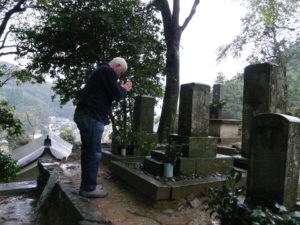
(Photo shown above is at Hanpeita’s grave in Kochi, November 2015.)
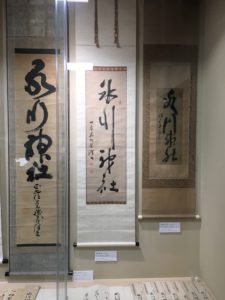
Earlier this month my friends Minako Koyama and Michio Tsuda and I visited the Hikawa Shrine in Tokyo’s Akasaka district, near the site of Katsu Kaishu’s residence. (Ms. Kohyama is a great great grandchild of Katsu Kaishu. Mr. Tsuda is a direct descendent of Katsu Kaishu’s friend, Tsuda Sen.) We had the special opportunity to view these hanging scrolls with calligraphy written by Katsu Kaishu, Yamaoka Tesshu and Takahashi Deishu – “Bakumatsu no Sanshu.”

It’s common knowledge that Ryoma knew Kaishu. But until I had read a recent book by my good friend Kiyoharu Omino, “Ryoma no Yuigon,” I did not know that Ryoma had actually met Tesshu and Deishu.
From the shrine we walked to the nearby statue of Katsu Kaishu and Sakamoto Ryoma, unveiled last month at the site of Kaishu’s residence. (Ms. Kohyama is in the photo below.)
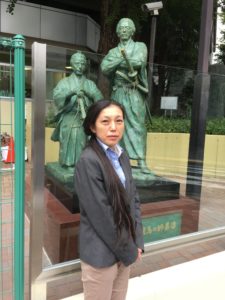
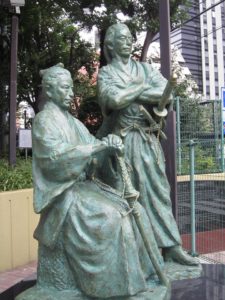
先日、高山みなこさん(勝海舟のご子孫)と津田道夫さん(海舟の友人、津田仙のご子孫)と共に赤坂の氷川神社に行った際、幕末三舟の書の掛け軸を拝見させてもらいました 。私の親友である小美濃清明氏が去年出された「龍馬の遺言」の第4章「龍馬はなぜ三舟と会ったのか」に書いてあるように、龍馬が山岡鐵舟と高橋泥舟に江戸で会ったことを思い出して感動しました。氷川神社の近くにある、海舟の屋敷跡に最近建てられた海舟と龍馬の師弟像も見物できました。銅像の前に立っているのは高山さんです。
(I wrote about “Bakumatsu no Sanshu” in my forthcoming Samurai Assassins, to be published by McFarland next year.)
